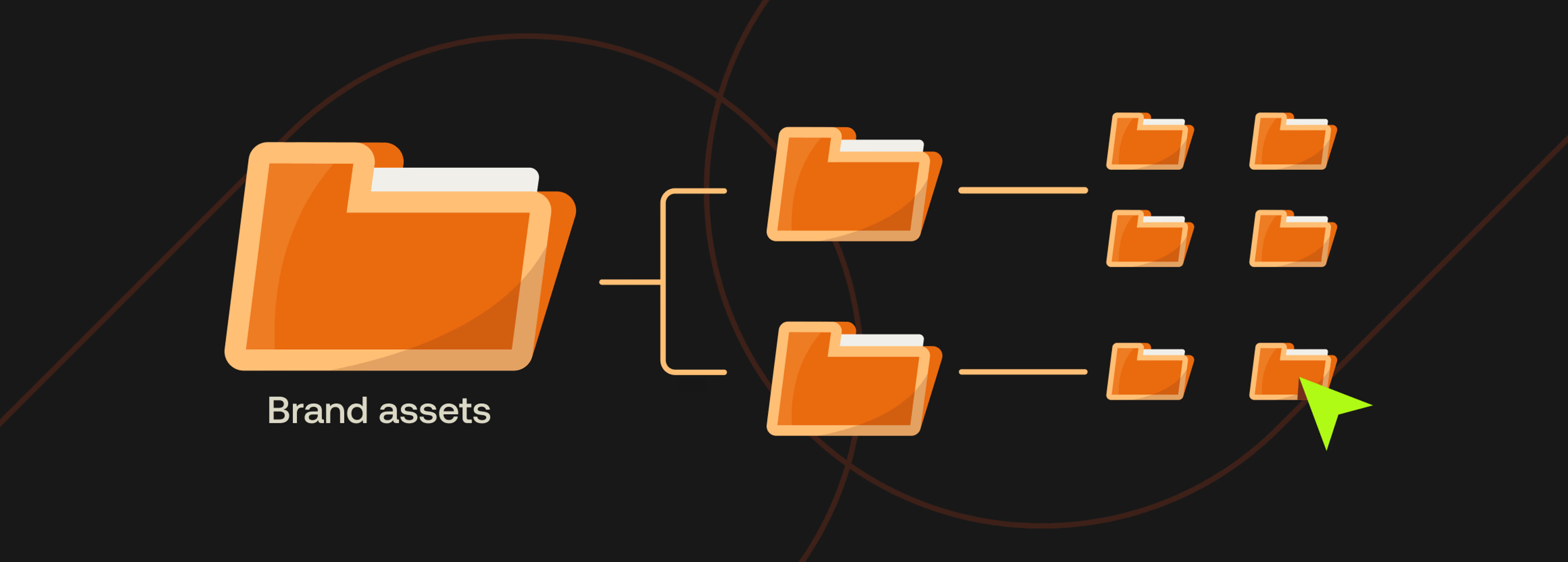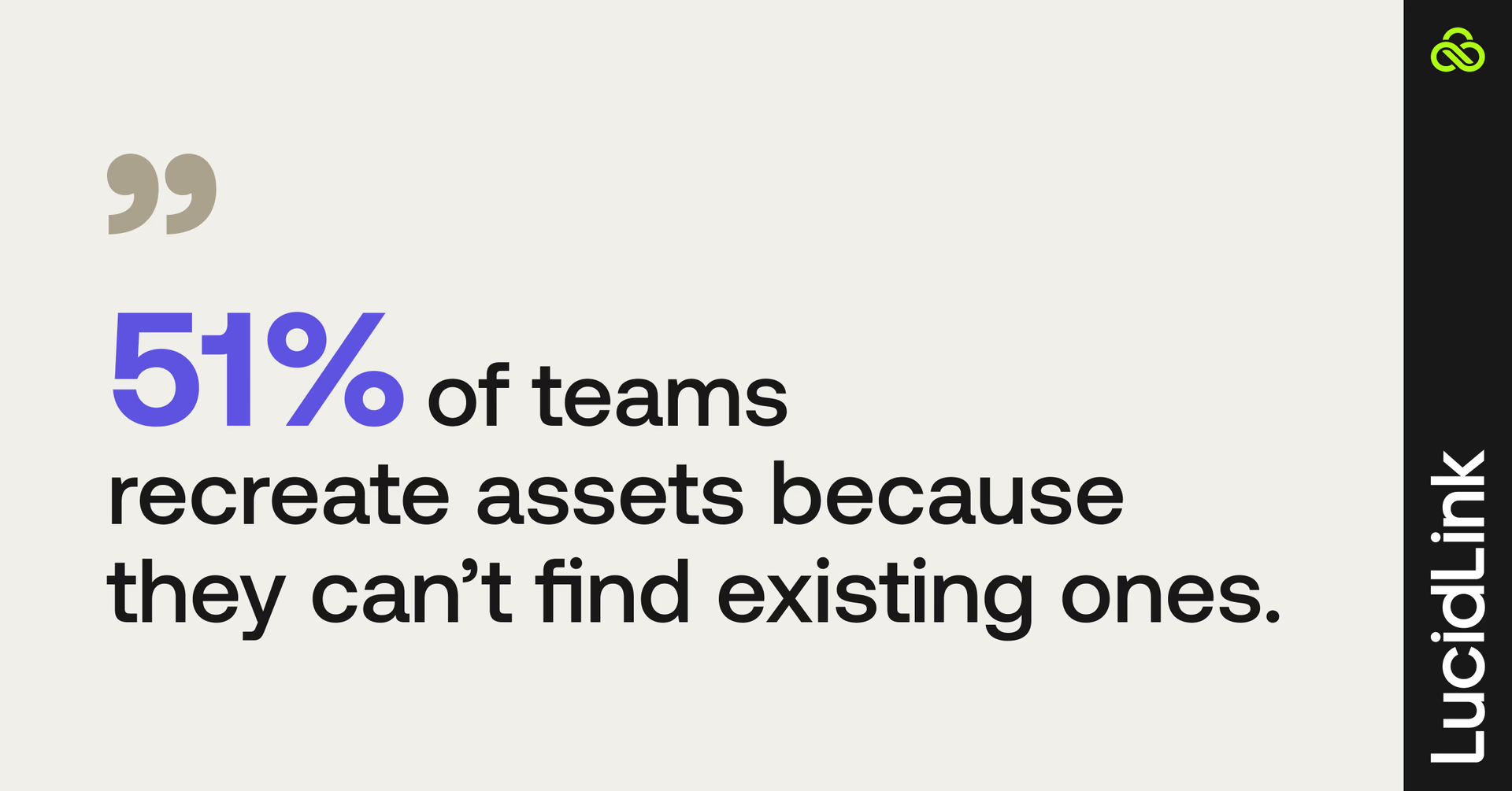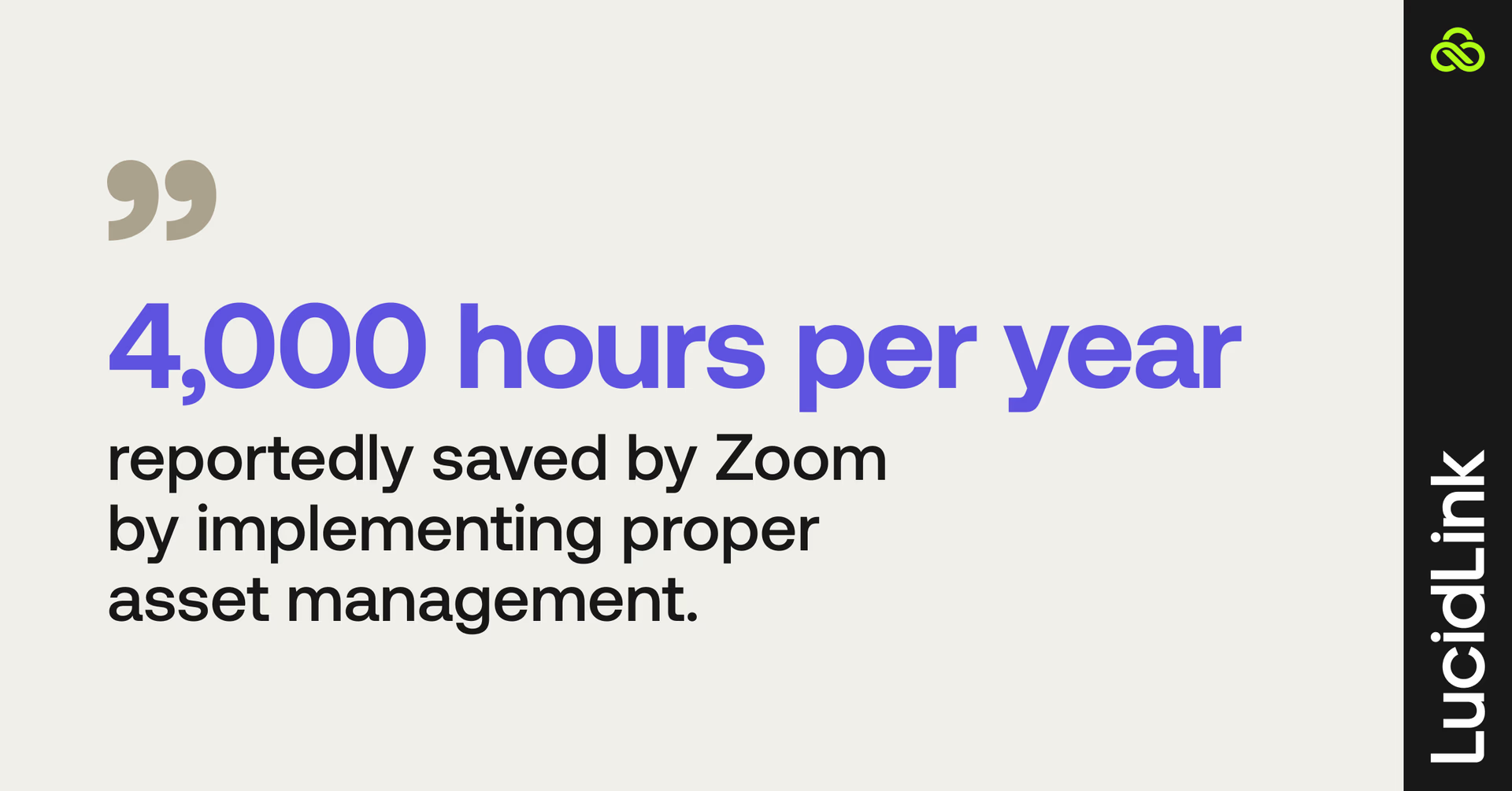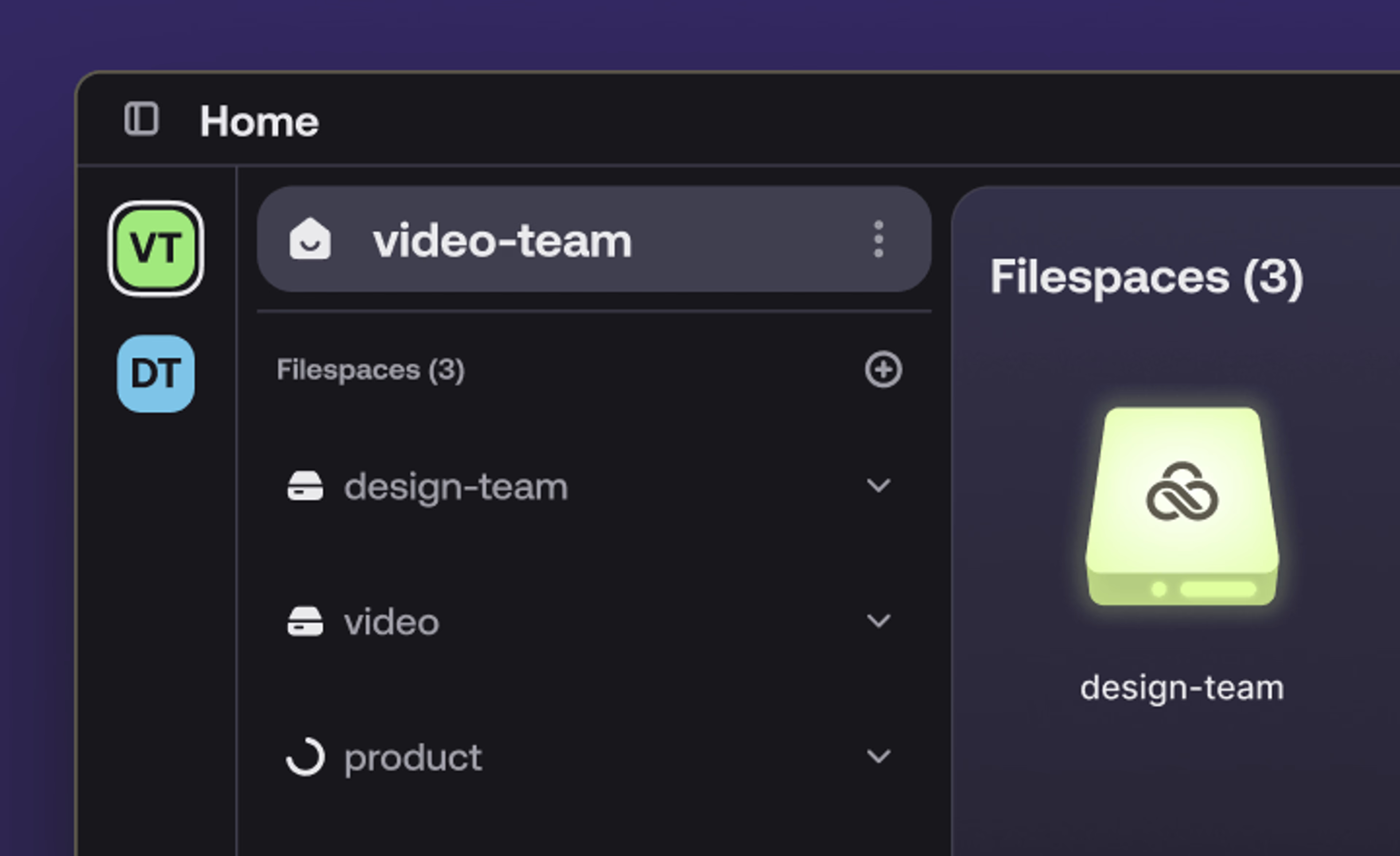Marketing asset management: how to stop wasting time & money
March 2025
10 mins

Your team creates a mountain of marketing assets every month — but how easy is it to find, share or update them?

If your workflow involves digging around for the latest logos, approved videos and other files, you're not alone. Marketers waste an alarming amount of time on file admin instead of marketing. One study found that 51% of teams simply recreate assets because they can’t find existing ones.
Let that sink in. It’s a huge waste of time and money. And the knock-on effect includes blown timelines, inconsistent output and spiraling costs.
One simple way to stop the waste is investing in marketing asset management. Let’s explore what it is and how it could help you and your team work smarter, better and happier.
What is marketing asset management?
Marketing asset management is exactly what it sounds like: the process of organizing and storing digital marketing materials in a centralized system.
It keeps your digital workspace tidy, ensures everyone knows where the latest logo is when they need it and keeps the brand consistent.
What sort of marketing assets can be managed? Pretty much all of them: videos, audio, infographics, logos, white papers, webinar recordings, case studies, slide decks, motion graphics and so on. If it’s the sort of thing you can upload to the cloud or email to a client or colleague, you can store it securely in a marketing asset management system.
Marketing asset management vs. digital asset management (and more)
Marketing asset management (sometimes shortened to MAM) is similar to a handful of other processes and disciplines that all have very similar names.
You might even find the terms used interchangeably sometimes, differentiated more by use-case than feature-set. Let’s quickly untangle some of these terms.
Video asset management (sometimes called VAM) is the process of storing and organizing video content. It’s made for video teams to collaborate remotely and sometimes also called media asset management.
Creative asset management is a similar system tailored specifically for creative teams. It’ll skew toward sharing designs, gathering feedback and logging approvals between copywriters, strategists, photographers, designers and clients.
Digital asset management (sometimes called DAM) is similar to marketing asset management but goes much broader. It’s usually engineered so everyone in a single organization can use it, rather than one team.
Content management systems (sometimes shortened to CMS) are quite different from the above. They’re used to create digital content on websites, like blog posts. They’re a website’s back-end.
All of these similar terms help highlight the specific uses and needs of marketing teams: collecting, organizing and finding the media they need, when they need it.
The cost of poor marketing asset management
When files are scattered across drives, email threads and personal folders, it doesn’t just create headaches — it costs real time and money. Here’s what that looks like in practice:
Key assets could be stored in lengthy and unsecure email chains.
Outdated or — worse! — unapproved logos could appear on signs at a major event.
Storage costs could spiral out of control as endless iterations end up saved in endless labyrinths of folders.
On a day-to-day basis your team could waste countless hours playing detective to find approved colorsets, templates, videos and more.
This time adds up fast. Zoom, for example, reported that they saved some 4,000 hours per year by implementing proper asset management.

Every minute spent hunting for files, waiting for downloads or figuring out version control is a minute not spent on strategy, creativity or execution.
What could you accomplish with all that extra bandwidth? That’s a large enough tally to equal concrete additional revenue, breathing room and creative headspace.
Why marketing teams need asset management software
On the flipside, a well-structured asset management system eliminates the chaos. Good marketing asset management software can lead to:
Streamlined marketing workflows. Productivity can skyrocket if the team is spending less time looking for (or recreating) assets.
Brand consistency. No more searching for the right version of a logo or the most updated template for a sales call.
Reduced storage costs. Endless folder hierarchies and duplicated assets can be eliminated.
Better collaboration. Remote, hybrid and in-office teams alike will be able to access a “single source of truth” for all information and assets.
Smarter analytics. Many marketing asset management platforms contain insights about how much a single asset is used or accessed, providing pointers on what might need to be refreshed (and which assets aren’t as useful).
Smoother compliance and more secure security. Any real MAM solution should allow you to manage users, encrypt confidential information and better comply with any industry-specific guidelines you may be facing.
Those benefits all probably look pretty good to anyone who has worked in marketing for awhile. Let’s look a little closer at what sort of qualities you want to keep an eye open for in a media asset management platform.

The anatomy of well-organized marketing asset management
One thing worth acknowledging is that you’re probably already managing your media assets with some level of organization.
Maybe you’ve got a folder system the team uses well, or you feel good about version control. Maybe you simply don't feel like you need a system in place … yet.
But MAM requires ongoing maintenance, and a good system will tidy up your entire operation. You can do a lot of this through any cloud storage or cloud collaboration platform, or you can opt for some of the paid platforms out there that will streamline onboarding and upkeep.
No matter what, your media asset management solution should include:
Centralized organization. Everyone should be able to access the files they need, and one person (or a small group) should be responsible for keeping folders and file names consistent. For example, a well-structured system might have clearly labeled folders for each campaign, a permissions system for internal vs. external users and automated version tracking to avoid duplicate files.
Version control. You likely want a way to track different iterations of the same piece of content, so you can revert to an earlier version if necessary. But you also want people to be able to grab the newest version easily. A good MAM system keeps versions organized.
Instant access. You want people to be able to use and manipulate the assets quickly, no matter where they’re accessing the media from.
Access management. For larger teams, you may want some users to have different levels of access to different folders and kinds of assets. Clients may only have access to a folder clearly marked “EXTERNAL,” for example. Don’t save the brainstorm notes there!
Security. Look for the ability to gate assets behind passwords, or even more secure encryption protocols like SOC 2 Type 2.
Integrations. Lastly, your media asset management solution should play nice with everything else your team uses. If you live on PhotoShop or DaVinci or Trello, look for a product that integrates with your chosen tools, and watch the efficiencies compound.
If you’re ready to start shopping for some tools, read on.
Worth including tools where relevant, but can point to creative asset management blog if it’s going to be the same stuff.

How LucidLink helps marketing teams manage assets effortlessly
There’s a lot of great MAM software out there, including MediaValet, Aprimo and Acquia.
But we’re a little biased: LucidLink is the secret sauce that helps marketing teams stay organized. It’s not a media asset management tool, but rather a cloud collaboration platform that can enhance a MAM system or even replace one outright. Here’s how it works.
Instant access, no learning curve
Your team accesses shared cloud storage using the same file browser they use on their regular computer. There’s no fussy new system to wrangle or educate them on, just the same drag-and-drop interface they know and love.
No uploads or downloads.
No syncing delays.
No time wasted hunting for files.
If a contractor based in Dubai has finished a new edit of a video, it can be reviewed by a colleague in Miami instantly, without syncing, uploading or downloading. It’s as if your team is sharing the same hard drive.
One source of truth for your team
Because LucidLink’s filespace is centralized, everything stays in one place:
Folders stay organized: managed by one person or team.
Version control is seamless: always access the latest file.
Access is controlled centrally: only the right people see the right assets.
It’s storage collaboration without the chaos.
Scalable and secure
LucidLink features zero-knowledge encryption (aligned with the SOC 2 Type 2 standards), so you can rest easy that all of your assets are secure.
And, lastly, it integrates seamlessly with many of the most popular programs used by marketing teams, including Creative Cloud.
A smart alternative to traditional MAM
For larger companies, LucidLink is a powerful add-on to traditional MAM software, offering instant collaboration between far-flung colleagues (or hybrid teams tweaking work from home).
But for smaller teams, traditional MAM may be overkill. LucidLink provides a faster, simpler way to stay organized without the complexity of a heavy MAM system.
If you’re interested in giving it a spin, sign up for a free trial today.
Marketing asset management best practices
No matter which path you choose, marketing asset management is only as good as its maintenance. Here are a couple of best practices for getting up and running.
Decide on naming conventions. If in doubt, go with client_project_deliverable_version.
Decide whether you’ll use tagging and metadata. Within your folders, you can tag or code individual files with colored dots, keywords and expiration dates to help stay organized. If you’re unsure, don’t add this more complicated taxonomy just yet — but keep it in mind as a possible evolution.
Regularly review usage and standards. Figure out a cadence to do a periodic sweep of the storage system: cleaning up files, deciding which assets need refreshed and reviewing your organization system as a whole.
Create a simple one-sheet to ensure ease of use. A MAM system is only useful if everyone knows how to do it. Figure out how to communicate what’s essential to the team and make sure they keep it handy.
Of course, that list of instructions is incredibly easy if you’re using LucidLink, since it’s as easy as using the file browser on your computer. But it’s still worth making sure everyone has the instructions they need to maintain your asset management system.
The future of marketing asset management: what’s next?
The need for marketing asset management is going nowhere. It was a $4.2 billion industry in 2023, and is expected to grow 16.2 percent year over year through 2030.
As marketing teams continue to scale, saving time won’t just be about better organization — it’ll also be about smarter automation. Here’s how MAM is evolving to make workflows even more efficient.
AI-powered tagging. Artificial intelligence is everywhere these days, and it’s probably most useful in behind-the-scenes applications like this. Imagine simply dropping an asset into a platform and having it intelligently coded and organized for you.
AI-powered search. Alternatively, imagine asking a chatbot for something specific — like, say, vector-logos for signage at an event — and having it serve you exactly what you need.
Automating asset approvals and updates. One consistent headache for distributed teams is complex approval chains requiring multiple sign-offs needed in various stages. Newer systems are starting to integrate with project management workflows to make these approvals smoother.
Real-time cloud collaboration. LucidLink is already a quantum leap forward in terms of storage collaboration, but expect media asset management to continue to emphasize the ability for colleagues to work on assets simultaneously.
Advanced analytics. Data is only useful when it’s being used. As MAM platforms scale, expect them to continue to track how things are used, surfacing which pieces have the best ROI and which need to be retired or updated.
Media asset management is a utilitarian space, but it’s also an exciting one, with lots of opportunity for innovation.
Save time by getting your marketing assets under control
You wouldn’t trust a mechanic who kept every tool in a pile under a large tarp. Digital workspaces are no different.
Due to the large amount of assets you produce and work with, as well as the variety of contractors, clients and disciplines working with you, marketers are particularly prone to disorganization.
Marketing asset management can help your team get all of its storage bloat under control permanently. You can streamline operations, save money, produce better work and improve overall workplace happiness with a bit of spring (or summer, or winter, or fall) cleaning.
What will your team do with all that extra time?
LucidLink can help you get started. Try it out for marketing asset management with a free trial today.
Keep reading

How The Finish Line reclaims time to make work-life balance a reality
Discover how The Finish Line uses cloud workflows to support remote post-production, creative collaboration and make every second count.
10 April 2025, 6 mins read

What is LucidLink and how does it work?
Learn all about LucidLink, the storage collaboration platform that gives teams instant, secure access to files from anywhere.
27 March 2025, 8 mins read

8 workflow bottlenecks stealing your time (and how to fix them)
Struggling with version chaos, slow approvals or file delays? Fix these 8 common workflow challenges to get back to doing your best work.
11 March 2025, 7 mins read
Join our newsletter
Get all our latest news and creative tips
Want the details? Read our Privacy Policy. Not loving our emails?
Unsubscribe anytime or drop us a note at support@lucidlink.com.